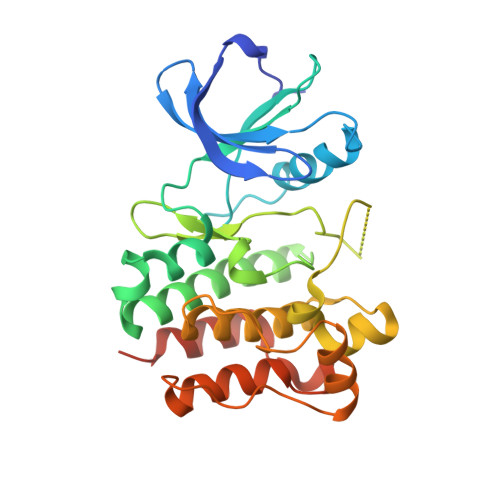Crystal Structures of the Lyn Protein Tyrosine Kinase Domain in Its Apo- and Inhibitor-bound State
Williams, N.K., Lucet, I.S., Klinken, S.P., Ingley, E., Rossjohn, J.(2009) J Biol Chem 284: 284-291
- PubMed: 18984583
- DOI: https://doi.org/10.1074/jbc.M807850200
- Primary Citation of Related Structures:
2ZV7, 2ZV8, 2ZV9, 2ZVA - PubMed Abstract:
The Src-family protein-tyrosine kinase (PTK) Lyn is the most important Src-family kinase in B cells, having both inhibitory and stimulatory activity that is dependent on the receptor, ligand, and developmental context of the B cell. An important role for Lyn has been reported in acute myeloid leukemia and chronic myeloid leukemia, as well as certain solid tumors. Although several Src-family inhibitors are available, the development of Lyn-specific inhibitors, or inhibitors with reduced off-target activity to Lyn, has been hampered by the lack of structural data on the Lyn kinase. Here we report the crystal structure of the non-liganded form of Lyn kinase domain, as well as in complex with three different inhibitors: the ATP analogue AMP-PNP; the pan Src kinase inhibitor PP2; and the BCR-Abl/Src-family inhibitor Dasatinib. The Lyn kinase domain was determined in its "active" conformation, but in the unphosphorylated state. All three inhibitors are bound at the ATP-binding site, with PP2 and Dasatinib extending into a hydrophobic pocket deep in the substrate cleft, thereby providing a basis for the Src-specific inhibition. Analysis of sequence and structural differences around the active site region of the Src-family PTKs were evident. Accordingly, our data provide valuable information for the further development of therapeutics targeting Lyn and the important Src-family of kinases.
Organizational Affiliation:
Protein Crystallography Unit, Department of Biochemistry and Molecular Biology, School of Biomedical Sciences, Monash University, Clayton, Victoria 3800, Australia, and the Laboratory for Cancer Medicine and Cell Signalling Group, Western Australian Institute for Medical Research and Centre for Medical Research, The University of Western Australia, Perth, Western Australia 6000, Australia.















